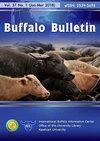Polypropylene mesh versus nylon mosquito net mesh for external abdominal hernias repair in cattle and buffaloes
IF 0.2
4区 农林科学
Q4 AGRICULTURE, DAIRY & ANIMAL SCIENCE
引用次数: 0
Abstract
Herein, the effectiveness of locally sourced and autoclaved nylon mosquito net mesh for the repair of external abdominal hernias was investigated. Eleven animals (7 cattle and 4 buffaloes) having hernial ring sizes of 8 to 30 cm in diameter were divided into two Groups 1 (5 animals) and Group 2 (6 animals). In Group 1, nylon mosquito net mesh was used, and in Group 2, polypropylene mesh was used for the repair of defects. The animals were sedated with xylazine HCl and given local anaesthesia during surgery. Over the external hernial sac, an elliptical skin incision was made. The internal hernial sac was bluntly dissected and freed down to the hernial ring. The internal hernial sac was opened, and the hernial ring was repaired with nylon mosquito net mesh or polypropylene mesh using the inlay technique. After hernioplasty, the sac and subcutaneous tissue were repaired with prolene suture material. The skin incision was closed with simple interrupted mattress sutures using monofilament polyamide suture material. Antibiotics and analgesics were given postoperatively, and povidone iodine was used to treat the suture line daily. The skin sutures were removed on the 10th to 15th postoperative day, depending upon the wound condition. Mild inflammatory swelling in Group 1 was observed at the incision line, which had completely subsided by the 15th postoperative day. The wounds healed by first intention in both groups. In any case, no recurrence was seen in a follow-up period of 3 months. Without clinical signs of wound dehiscence, infection, or recurrence, all animals recovered uneventfully.聚丙烯网与尼龙蚊帐网在牛和水牛腹外疝修补中的比较
在此,我们研究了局部来源和蒸压尼龙蚊帐网用于腹外疝修复的有效性。将疝环直径为8 ~ 30 cm的动物11只(牛7只、水牛4只)分为1组(5只)和2组(6只)。第1组采用尼龙蚊帐网,第2组采用聚丙烯网进行缺损修复。手术中给予盐酸噻嗪镇静和局部麻醉。在外疝囊上方,做一个椭圆形皮肤切口。直接切开内部疝囊,释放至疝环。打开内疝囊,采用尼龙蚊帐网或聚丙烯网嵌体技术修复疝环。疝成形术后,气囊和皮下组织用丙烯缝合材料修复。皮肤切口采用单丝聚酰胺缝合材料进行简单间断床垫缝合。术后给予抗生素和镇痛药,每日应用聚维酮碘治疗缝合线。根据创面情况,于术后第10 ~ 15天拆除皮肤缝合线。第1组在切口线上出现轻度炎症性肿胀,至术后第15天完全消退。两组创面均首次愈合。随访3个月均未见复发。所有动物均无伤口裂开、感染或复发的临床症状。
本文章由计算机程序翻译,如有差异,请以英文原文为准。
求助全文
约1分钟内获得全文
求助全文
来源期刊

Buffalo Bulletin
AGRICULTURE, DAIRY & ANIMAL SCIENCE-
CiteScore
0.50
自引率
0.00%
发文量
53
审稿时长
>12 weeks
期刊介绍:
Buffalo Bulletin is published quarterly in January-March, April-June, July-September and October-December. Contributions on any aspect of research or development, progress reports of projects and news on buffalo will be considered for publication in the bulletin.
 求助内容:
求助内容: 应助结果提醒方式:
应助结果提醒方式:


